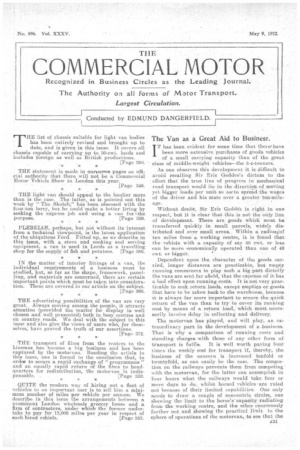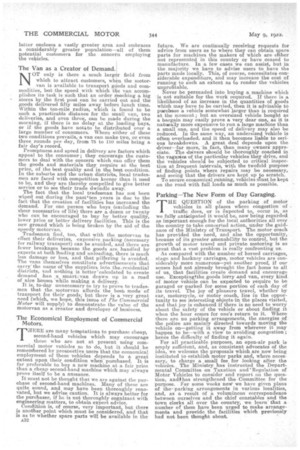The Van as a Great Aid to Business.
Page 1

Page 2

If you've noticed an error in this article please click here to report it so we can fix it.
IT has been evident for some time that therehave been more extensive purchases of goods vehicles of a small carrying capacity than of the great el-ass of middle-weight vehicles—the 3-4-tonners.
As one observes this development it is difficult to avoid recalling Sir Eric Geddes's dictum to the effect that the true line of progress in mechanical road transport would lie in the direction of moving yet bigger loads per unit so as to spread the wages of the driver and his mate over a greater ton-mileage.
Without doubt, Sir Eric Gedd6's is right in one respect, but it is clear that this is not the only line of development. There are' goods which must be transferred quickly in small parcels, widely distributed and over small areas. Within a raditisiof 'ten miles from' a. working Centre, it is found that thevehicle with a capacity of say 30 ewt. or less can be more economically operated than one of 40 • cwh or bigger. .
Dependent upon the character of the goods carried, longer distances are practicable, but empty running commences to play such a big part directly the vans are sent far afield, that the expense of it has a had effect upon running costs. It is not very practicable to seek return loads, except empties or goods that have to be taken back to the warehouse, because it is always far more important to secure the quick return of the van than to try to cover its running cost by means of a return load, which must necessarily involve. delay in collecting and delivery.
The motorvan has played, and will play, an extraordinary part in the development of a -business. That is why a Comparison of running costs and. standing charges with those of any other form of teansPort is futile. It is well worth paying four times the weekly cost for transport if, thereby, the business of the concern is increased tenfold or twentyfold, as can easily be the case. The congestion on the railways prevents them from competing with the motorvan, for the latter can accomplish in four hours what the railways would take four or more days to do, whilst horsed vehicles -are ruled out because of their limited capabilities. One only needs to draw a couple of concentric circles, one showing the limit to the horse's 'capacity radiating from the working centre, and the other enormously farther out and showing the practical limit to the sphere of operations of the motorvan, to see that the latter encloses a vastly greater area and embraces a considerably greater population—all of them potential customers for the concern employing the vehicles.




































